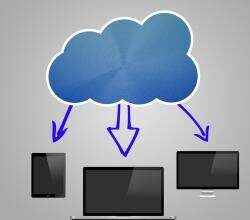
Think about how many of your employees use their personal devices for work.
How many use their cell phones to check company email? How many use personal computers to work on files during a business trip?

Think about how many of your employees use their personal devices for work.
How many use their cell phones to check company email? How many use personal computers to work on files during a business trip?
If you estimate at least half, you’re not far off. In fact, across all industries, about 40 percent of employees use their personal devices for work-related purposes. And while this might not seem like a pressing problem, it is indicative of the growing consumerization of IT — a trend that businesses must adapt to in order to keep their data secure.
In the world of cloud computing, file-sharing, and mobile technologies and devices, the traditional approach to enterprise hardware is no longer the norm. As you might see in your own workforce, individuals and businesses alike are now reliant on their mobile devices, and often turn to their personal devices for convenience. Likewise, personal email applications, file-sharing services, and other software is used instead of the standard-issue company components.
Convenience is a motivating factor for using personal devices: After all, who wants to carry around two cell phones, if they can help it? File-sharing is also an easy way for employees to exchange files, often with third parties. Recently, Hillary Clinton served as the poster child for the growing conflict between IT security and end user ease-of-use. IT departments obviously want to keep control of their information, and users want the ease of accessing and sharing information wherever they are.
However, the increased use in these private devices and open-file-sharing services leave room for loss of data and threats from cyber criminals. To combat these issues and prepare for the consumerization of IT, businesses need to adapt. In doing so, they must remodel the structure of their business, designing for a loss of control, and making it easier to adopt innovative technologies and remain agile.
The adoption of such innovative, collaborative technologies offers organizations the ability toreduce IT end-user support, increased worker productivity, and the ability to improve external relationships. A survey conducted by Frost and Sullivan found that companies that invest in collaborative technology enjoy a 400% return on investment.
Though file sharing, cloud computing and even mobile devices have made it easier than ever to share files, many businesses still fear the issues of security: Who can see confidential files? Who has access to such files? And how do we keep sensitive files private?
One way to account for such security issues is to adopt programs that allow persistent, remote control of access to such documents. This new area of control is referred to as Information Rights Management. Based on the premise of information-centric security, Information Rights Management is the best way to ensure that sensitive information is kept safe as it goes up in the cloud, is shared via file-sharing services, or leaves the perimeter of the organization via email. With IRM controls in place, businesses can prevent an individual from screen captures, saving and/or printing a particular document if it contains sensitive information — or restricting access completely. This secure document sharing even provides control over where and when content is used as well. For example, you can limit the access to a specific device (desktop within corporate network) and set an automatic expiration date.
Shifting to an information-centric security model enables an organization to confidently embrace new technologies and address the consumerization of IT. Now if a mobile device is lost, there are no worries since the sensitive information is protected. If someone sends an email to the wrong person or a file-sharing service is hacked…it won’t matter because the recipient can only open the attachment if they have permission. And any file-sharing system can be made secure, enabling you to offer employees and partners full flexibility in how information is exchanged.







